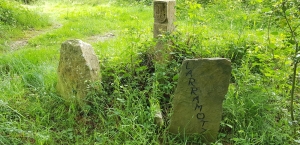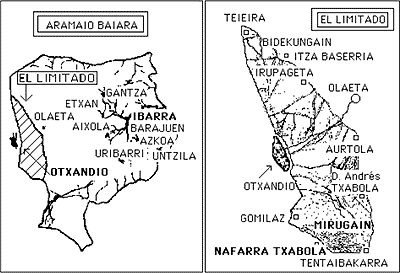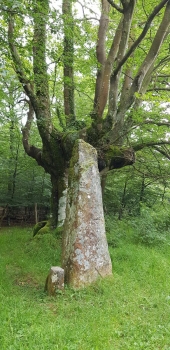A ritual that builds community identity. The "basabisitta" of Otxandio
- 06/ 11/ 2001
Describes the ritual celebrated in the town of Otxandio whereby townspeople check the position of the various boundary markers delimiting their territory. This description is followed by an analysis of the ritual using the parameters established by Arnold Van Gennep, and relevant conclusions are drawn based on the these findings.

n the third Sunday of September each year, the townspeople of Otxandio, accompanied by the municipal corporation, sets out from the town square in the early morning, to the beat of a drum. Their walk - which will conclude eight hours later in the same place - takes in the most emblematic places on the hill known as El Limitado. This land, which is owned by the valley of Aramaio, has been occupied and used continuously by the people of Otxandio since 1457, when the council and townsfolk were awarded the right to use its pastures, wood, tillage, etc. It has been at the centre of numerous lawsuits, and since at least since the seventeenth century, has been the setting for the ritual discussed in this anthropological analysis.

The route
On the day of the 'Basabisitta', local people (men, women and children) begin to arrive in the town square at seven o'clock in the morning, to await the beat of the drum to start out on the walk. Half an hour later, the "alguacil" - or constable / bailiff beats the drum. The basabisitta has begun. The Mayor, Councillors and the Forest Guards take their place at the head of the retinue, made up of some three hundred people.
In Gomilaz, formerly a hostel and now been turned into a restaurant, the retinue divides into two groups. None tenths of the participants, accompanied by the mayor and the Municipal Corporation head off towards El Limitado. A small group of others accompanies the deputy mayor to inspect the "mugarriak" or boundary markers that delimit the town of Otxandio from the lands of Dima. The larger group makes its way towards the Mirugain, a hill located to the south of El Limitado. The boundary markers begin in a place known as Nafarra Txabola, to which access is by means of a steep, pine-covered slope. In the past, the tree that marked the boundary was a birch, which into which a notch was cut with an axe. This system is still used in the Basabisitta. Today, oaks and beech trees are also marked. Boundary stones dating from the eighteenth century can still be seen at the limits between Legutio -Villarreal- (the hill of Itesasi) and El Limitado.
The Forest Guard, armed with a double-edged axe (one side has a cutting blade and the other a seal with the coat of arms of the town of Otxandio) marks the trees in the traditional way, making a small cut in the bark of the tree and branding it with the town seal. Later, the gathering comes to Tantaibakarra. Here the people have their first rest, as they await the arrival of the mayor and municipal councillors. They sit in a circle, surrounding a place that represents a rock that once stood in the spot. A few hundred metres away stands the hut of Don Andrés. Now is the time to have something to eat. The members of the town council distribute bread, wine and fried cod.
There follows a long walk from Don Andrés to Aurtola. The people halt again in Mártola. The path is overgrown with ferns, holly, gorse and heather (iri, goresti, otea, iñarri), a sure sign that the pine plantations have not penetrated here. After walking along paths, forest trails and the famous "gorribidea" (the path of the reds), they come to Aurtola, an outlying district of the village of Olaeta. Under an oak in a farmer's garden, now turned into a restaurant, the members of the retinue, preceded by the Mayor, sign the minutes, after which they set off once again. They then pass through Irupageta, to come to the farmhouse called Itza. This is very good grazing land for cattle, and its meadows are a sharp contrast to the thick vegetation that has accompanied the Basabisitta until now.
Finally, the people walk along the "Bidekungain" (the upper Via Crucis) and come to Teieixe (yew grove). Here the two groups that had split up in Gomilaz at the beginning of the walk, meet up again. An old school, now converted into a "txoko" or eating club and the surrounding field are the venue for the distribution of the last food, offered by the Town Council. Five hours after they set out, the group, scattered along the route, comes together again to enter the town, accompanied once more by the sound of the drum.
(1) According to the legend, this drum is beaten to scare off spies from Aramaio. If we are to believe the participants at the "basabisitta", however, the explanation is much simpler - it is intended merely to marshal local people to take part in the event. Local folklore tells the story of a rooster to explain why El Limitado belongs to the valley. According to the legend, the limits between Aramaio and neighbouring towns were settled by a race. At some time in history - not clearly specified - there were constant conflicts between Aramaio and its neighbours. In order to decide where the limits should stand, local people consulted a holy man who lived in the caves of Lezia. He proposed a race for which he set out the conditions. At daybreak, at the first crowing of the cock, the young people from the other towns in conflict should run from the main squares in their respective towns towards Aramaio; similarly, the young people from the valley should run towards the towns with which they were in conflict and the place where they met would mark the boundary. Since there were no clocks, the signal for the start of the race would be the crowing of the cock. A man from Aramaio placed a sieve in the window of his henhouse. He then put a pale light behind the window. Thus lit, the sieve gave the impression of daybreak inside the henhouse. The rooster was taken in and began to crow. The young people from Aramaio left their town and ran as far as the gates of the other towns with which the valley was in litigation. This is the popular explanation for the current limits of the valley, which extend to the very gates of the neighbouring towns.
The ‘basabisitta’ as a rite of community identification
The Basabisitta is a ritual claim over a territory whose possession the local people assert and whose rights they do not want to lose. The Basabisitta, then, is an emblematic rite of identity, in which a series of codes frame the individuals and the institutions of Otxandio, defining them as a community in contrast to another group (the people of Aramaio). In the Basabisitta, the community of neighbours is territorially rebuilt. It is not only a territory or right that is being laid claim to; it is a community that is built, reinforced and united.
Using Van Gennep's structure for rites of passage, we can see his three key moments: separation, transition (liminal state) and incorporation.
The separation consists of the disorderly setting out from the village, with the ordering rhythm of the drumbeat. The rite is not accompanied by bells, rockets or festival costumes. This is a pilgrimage, a mountain walk. Everyday clothes have been replaced by the knapsack, the walking stick and the hiking boots. All these elements enable a break to be made; a beginning, an entry into a new time and a different space. El Limitado is a reserve, the remains of the traditional mountain unaffected by modern forestry operations. The participants advance towards the past, which can be found at the gates of their town, to consolidate the common ties of life and neighbourhood.
The direction of the walk follows that of ritual pilgrimages in traditional societies: the Basabisitta is performed anti-clockwise. And it pass through the wildest part of the mountain; the most thickly forested with least human impact - a place of wild boar tracks, few paths, inaccessible areas, slippery slopes and traditional culture. The first stop is in the mountain, in Tentaibakarra. Here, human impact is limited to marks on the trees and the boundary markers.
The next resting point comes at Don Andrés' hut. This is not a place of permanent human habitation, but it is at least a place of shelter for animals and human activities. In former times in this country, the huts (or "txabolas") were the clearest sign of productive human presence on the mountainside.
The third resting place is at a farmstead (or "baserri"), a social element of vital importance in rural parts of the Basque Country, since it is the centre of social relations and at the same time the element that structures the geography and religious legal and economic life. This particular farmhouse has been turned into a restaurant, symbolic of the development of many Basque farmhouses in the country's process of industrialisation. Here, before continuing on towards a modern farm and towards the final point (a large field where there is a school - now converted into an dining club), all the participants sign the minutes.
What interests us about this walk is the progression. The route takes the participants from the least human to the most humanised, from the mountain to the permanent dwelling, to the valley, to the "auzo", or neighbourhood. The route has three key moments: the mountain, the baserri (farmhouse) and the auzo (neighbourhood). In other words, the people leave the town and return to it through the three spaces of life and social interaction in the past, integrating them and ritually forming the community around them. The geographical centre of the walk is the "baserri", which stands close to Olaeta (belonging to the valley of Aramaio), but it is not necessarily the ritual centre. The spatial relations of the rural communities of the Basque Country follow a circular order in which all elements are integrated in the trilogy formed by the baso-baserri-auzo (wild area / farmhouse / neighbourhood). In the rite, these three elements form the liminal moment. The progression culminates in the neighbourhood relations characteristic of traditional Basque society. But there are new elements, (the dining club) which form new symbols of the neighbourhood.
Everything seems to indicate that there is a desire for self-definition around that which was indispensable in the society of the past: the house, the district and the mountain. The town of Otxandio faces the danger of losing one of these elements, indispensable for the life of the others, the mountain. Faced with this danger, it prepares a ritual action that reminds the community of its origins and its identity.
CONCLUSION
In understanding this rite, it is important to bear in mind that the space-related festive-ritual manifestations, can be analysed from three different and complementary perspectives. We are dealing with rites of initiation, identification and performance. In other words, we are dealing with rites that build community life around ways of life, values and symbols that reflect the survival of the community and that invite the participant to join them by expressing the collective belonging.
The visit to the town limits is a path of initiation towards the spatial origins of the community, towards a moment in its constitutional being involving the acquisition of a space indispensable for the logic of survival, and therefore of its survival itself. This walk is carried out in a continuum from separation to integration. This continuum marks the breaks, distinguishes the times and customs and prepares a code of conduct, inscribed in the space of the community, known as rotation and alternation, two traditional forms of social relationship in rural culture that reproduce the cosmological cycle of life / death / regeneration.
At the same time, it is a rite of collective identification since it sets the townspeople of Otxandio within the framework of a series of liminal / liminoid codes that identify them with an inclusive/including space in contrast to those from outside whose not-belonging is recorded, year after year, in the common pilgrimage, in the companionship and in the celebration of shared identity.

In short, this is an eminently performative rite; one which performs the action that it expresses. The appropriation of the land can be symbolic. The construction of the identity into a logic of belonging and permanence is real. The group defines itself as a member of an etxe (house), of an auzo (neighbourhood) and of baso (wild place); it does so by differentiating itself from the neighbouring community and affirms itself in the circular construction of the past. The rite incorporates the dispersed inhabitants of the town into a new sociological institution - that of the neighbours - who institute/constitute themselves into a new and renewed group every year.







